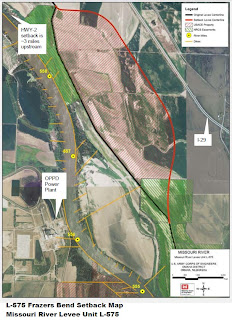When the Army Corps of Engineers was rebuilding levees along the Missouri River, they also did the work in a manner to create additional riverine habitat.
 All images courtesy of the Army Corps of Engineers. |
The two particular efforts were levee setback and excavating and grading borrow pits in a manner to allow wetlands to be established, said David J. Crane, an environmental resources specialist with the Corps.
This work was especially done at two sites in Iowa, Crane said.
- Copeland Bend Mitigation Site (river miles 560-565), adjacent to Highway 2, across from Nebraska City, Nebraska.
- Work here included approximately 3.6 miles of levee setback north of the highway and approximately one mile of levee setback south of the highway. This setback occurs along the Copeland Bend of the Missouri River, between river miles 565-560. About 760 acres of floodplain were opened at this site, nearly "doubling the total riverward habitat area at this location to 1,456 acres."
- About 200 acres of wetland habitat were created, planted with a native mix of wetland plant species that favor the generally sandy soils in the area.
- Frazers Bend (river miles 556-559); on the Iowa side of the river, about three miles south of the Highway 2 site.
- This setback is approximately three miles long. About 1100 acres of floodplain were opened, "bringing the new total riverward habitat area at this location to 2,098 acres."
- About 100 acres of wetland habitat were created, and will also be planted to a native mix of plant species.
The levees were being rebuilt due to damages associated with the flood of 2011.
The Iowa Department of Natural Resources (IDNR) and Natural Resources Conservation Service (NRCS), along with the local levee sponsors, Fremont County staff, and Iowa Department of Transportation were the main partners in completing this levee rehabilitation project along with the Corps of Engineers, Crane said.
 |
"Both agencies were coordinated with frequently throughout the planning and construction phase regarding: native seed mixes, wetland construction, setback levee alignment, location of borrow sites, road relocation," he said.
The Corps has recognized several ecosystem benefits that will occur because of these projects:
- "Increased floodplain and riparian habitat for fish and other wildlife
- "Provides needed spawning and nursery areas for many fish species during times of high water
- "Fish and other aquatic life entering the floodplain during high water provides food for foraging birds
and mammals
- "Floodwater movement across the floodplain produces plankton and aquatic insects
- "Increased groundwater recharge
- "More floodplain is open to receive nutrients deposited from flood waters
- "Sediment deposition and scouring creates diverse habitat and topography on the floodplain"
The Iowa Department of Natural Resources is in charge of managing these two public areas.
Coordination with the IDNR and NRCS will continue through monitoring of the wetlands created at the setback sites.
These projects are expected to be completed during March. A Corps' article provides further information on the levee setback project.


